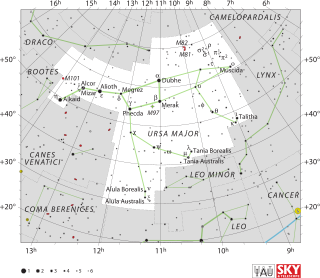| Observation data Epoch J2000 Equinox J2000 | |
|---|---|
| Constellation | Ursa Major |
| Right ascension | 08h 39m 11.70440s[1] |
| Declination | +65° 01′ 15.2667″[1] |
| Apparent magnitude (V) | 5.63 |
| Characteristics | |
| Spectral type | G1.5Vb[2] |
| U−B color index | +0.07[3] |
| B−V color index | +0.62[3] |
| Variable type | BY Draconis |
| Astrometry | |
| Radial velocity (Rv) | –13.88 ± 0.47[4] km/s |
| Proper motion (μ) | RA: -27.44 ± 0.31[1] mas/yr Dec.: +88.13 ± 0.26[1] mas/yr |
| Parallax (π) | 69.66 ± 0.37 mas[1] |
| Distance | 46.8 ± 0.2 ly (14.36 ± 0.08 pc) |
| Absolute magnitude (MV) | 4.86[5] |
| Details | |
| Mass | 0.90[6] M☉ |
| Luminosity | 0.97[7] L☉ |
| Surface gravity (log g) | 4.48[8] cgs |
| Temperature | 5,884 ± 6.8[9] K |
| Metallicity [Fe/H] | –0.04[8] dex |
| Rotation | 5 days[10] |
| Rotational velocity (v sin i) | 14.27[4] km/s |
| Age | 200[11] Myr |
| Other designations | |
| Database references | |
| SIMBAD | data |

Pi1 Ursae Majoris (Pi1 UMa, π¹ Ursae Majoris, π¹ UMa) is a yellow G-type main sequence dwarf with a mean apparent magnitude of +5.63. It is approximately 46.8 light years from Earth,[1] and is a relatively young star with an age of about 200 million years.[11] It is classified as a BY Draconis type variable star and its brightness varies by 0.08 magnitudes. In 1986, it became the first solar-type star to have the emission from an X-ray flare observed.[14] Based upon its space velocity components, this star is a member of the Ursa Major moving group of stars that share a common motion through space.[7][10]
An excess of infrared radiation has been detected from this system, which suggests the presence of a debris disk. The best fit to the data indicates that there is a ring of fine debris out to a radius of about 0.4 AU, consisting of 0.25 μm grains of amorphous silicates or crystalline forsterite. There may also be a wider ring of larger (10 μm) grains out to a distance of 16 AU.[15]
- ^ a b c d e f Cite error: The named reference
assl350was invoked but never defined (see the help page). - ^ Cite error: The named reference
mnras328_1_45was invoked but never defined (see the help page). - ^ a b Cite error: The named reference
clpl4was invoked but never defined (see the help page). - ^ a b Cite error: The named reference
aj133_6_2524was invoked but never defined (see the help page). - ^ Cite error: The named reference
Holmberg2009was invoked but never defined (see the help page). - ^ Cite error: The named reference
apjss192_1_2was invoked but never defined (see the help page). - ^ a b Cite error: The named reference
aj120_2_1006was invoked but never defined (see the help page). - ^ a b Cite error: The named reference
mnras374_2_664was invoked but never defined (see the help page). - ^ Cite error: The named reference
aaa411_3_559was invoked but never defined (see the help page). - ^ a b Cite error: The named reference
aaa521_A12was invoked but never defined (see the help page). - ^ a b Cite error: The named reference
apj687_2_1264was invoked but never defined (see the help page). - ^ Cite error: The named reference
MASTwas invoked but never defined (see the help page). - ^ Cite error: The named reference
Kochukhovwas invoked but never defined (see the help page). - ^ Cite error: The named reference
aaa157_2_217was invoked but never defined (see the help page). - ^ Cite error: The named reference
apj639_2_1166was invoked but never defined (see the help page).
